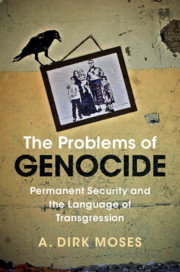Book contents
- The Problems of Genocide
- Human Rights in History
- The Problems of Genocide
- Copyright page
- Contents
- Preface
- Introduction
- Part I The Language of Transgression
- 1 The Language of Transgression, 1500s to 1890s
- 2 The Language of Transgression, 1890s to 1930s
- 3 Raphael Lemkin and the Protection of Small Nations
- 4 The Many Types of Destruction
- 5 Inventing Genocide in the 1940s
- Part II Permanent Security
- Part III The Language of Transgression, Permanent Security, and Holocaust Memory
- Index
2 - The Language of Transgression, 1890s to 1930s
from Part I - The Language of Transgression
Published online by Cambridge University Press: 07 January 2021
- The Problems of Genocide
- Human Rights in History
- The Problems of Genocide
- Copyright page
- Contents
- Preface
- Introduction
- Part I The Language of Transgression
- 1 The Language of Transgression, 1500s to 1890s
- 2 The Language of Transgression, 1890s to 1930s
- 3 Raphael Lemkin and the Protection of Small Nations
- 4 The Many Types of Destruction
- 5 Inventing Genocide in the 1940s
- Part II Permanent Security
- Part III The Language of Transgression, Permanent Security, and Holocaust Memory
- Index
Summary
This chapter historicizes the intersecting keywords of the “language of transgression” – shock, conscience, and mankind / humanity – since the early modern period when, I argue, we can locate its operation for the first time. The analysis focuses on the Western maritime empires that colonized the Americas, Oceania, and later Africa. Because we are interested in laying out the linguistic context from which Lemkin invented “genocide,” as well as the vested interests that went into its restricted legal meaning, this chapter highlights its operation and development as an instrument of power. The keywords in the language of transgression were naturally open to interpretation. And yet, a common feature in all their uses was the framing of exploitative and violent excesses – atrocities – as “barbaric.” Significantly, atrocities were understood not only as punctual events but as the outcomes of corrupt political and economic processes.
- Type
- Chapter
- Information
- The Problems of GenocidePermanent Security and the Language of Transgression, pp. 94 - 135Publisher: Cambridge University PressPrint publication year: 2021



